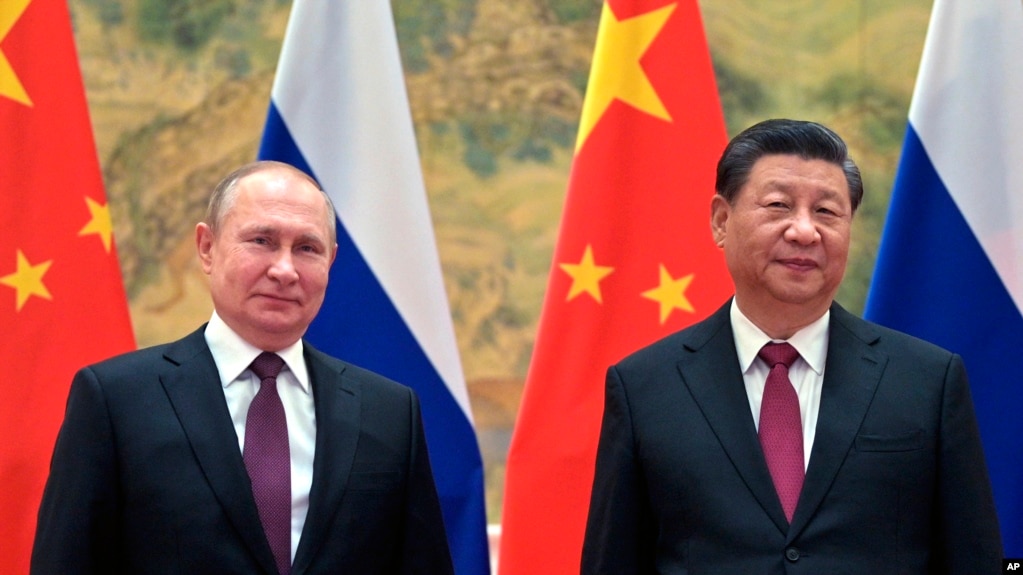(Destroyed Russian tanks at Bucha, Ukraine, May, 2022)
Following the collapse of the Soviet Union in 1991President George Bush Sr. announced a “new world order” as a focal point of American power. This vision was carried out in America’s moment, the defeat of Saddam Hussein forcing Iraq to withdraw from Kuwait and implementing certain policies to control the Iraqi dictator. For Bush and American policy makers these events symbolized the unipolar power structure in the world that would be dominated by the United States. A major premise fostered by the new unipolar world for American policy makers was that since the Cold War was over Russia would experience greater democracy if it could be drawn into the American orbit. Secondly, China could also be democratized if it could be integrated into the liberal economic realm led by Washington. Both suppositions have turned out to be a fantasy.
Today, the reality is clear – the Russian government has evolved into a revanchist regime led by a man who believes the worst event in Russian history was the collapse of the Soviet Union. Vladimir Putin’s main goal is to restore the glory of the Soviet Union and reassemble its empire. In the case of China under the leadership of Xi Jinping any subservience to the United States and the west would not allow China to achieve its rightful place of economic and political leadership in the world. According to the Chinese government any attempt to block Chinese growth would be a humiliation, not to be tolerated.

(Putin and Xi at the Beijing Olympics, February 2022)
How did the world balance of power evolve from a unipolar world under American leadership in the post 1991 era to a multipolar power structure today where two major powers, Russia and China have begun to cooperate to offset western economic power and political influence? The answer to this question, if in fact there is one forms the basis of New York Times National Security correspondent, David E. Sanger’s latest book, NEW COLD WARS: CHINA’S RISE, RUSSIA’S INVASION, AND AMERICA’S STRUGGLE TO DEFEND THE WEST.
China’s continuing rise to economic and political influence on the world stage has been and will continue to be fueled by nationalism and a sense of past grievance. The same can be said of Putin’s invasion of Ukraine, a decision based on personal ego and exacerbated by Russian nationalism. For Putin, Ukraine is an illegitimate country that has always been part of Russia. Similarly, Xi argues that Taiwan is not a country and has been and will be part of China in the future. These positions by two of the world’s most powerful autocrats creates a dilemma for the United States as to how it should proceed when confronting these new perceived threats.
Putin and Xi had a common interest; “to stand up to the United States, frustrate its ambitions, and speed along what they viewed as its inevitable decline.” After the events of January 6, 2021, the bifurcation of the American political system, the ongoing drama that is Donald Trump, the right wing white supremacist movement in the United States, economic inequality, and immigration issues as the 2024 election approached, all reinforced their view that their rationale was likely to evolve in their favor. The events between the fall of the Berlin Wall and the invasion of Ukraine reflect how western leaders who accepted historian Francis Fukuyama’s analysis of 1989 that we were experiencing the end of history: “that is the end of mankind’s ideological evolution and the universalization of western liberal democracy as the final form of human government” was totally misguided. What Sanger proposes is a dose of reality.

(In this Oct. 25, 2022 aerial photo, buildings and communication structures are seen on the China-built artificial island at Mischief Reef in the Spratly Islands, South China Sea)
Sanger has written a comprehensive and insightful work of contemporary history that everyone in Congress and the national security establishment should read. He writes with a verve that seemingly offsets any subject that might appear somewhat dry. In arguing his premises his facile mind seemingly encompasses all areas related to the “new Cold War” from a discussion of the history of the microchip and semi-conductors as it relates to China’s quest for world power to the historical “Finlandization” of the Russo-Finnish border after World War II and its contribution to Vladimir Putin’s paranoia when it comes to the west. Sanger’s monograph is more than a compilation of autonomous topics concerning the quest on the part of China and Russia to overturn American world dominance. It is a work of synthesis that seems to turn over every rock in his quest to explain the background for his book’s title and where the world balance of power stands today.
Writing at a time that the Russian invasion of Ukraine has entered its third year with Putin and Xi seemingly moving closer together Sanger has done a magnificent job. Sanger’s lengthy career, impeccable knowledge of national security policy and issues, and his access to the major players on the world stage make him the perfect candidate to take on such an important topic. Sanger’s dominant theme is an explanation of how we misjudged what would happen at the end of the Cold War and trying to discern what comes next at a time of maximum peril and increasing threats.
Sanger begins his study by providing intimate details of how and why Putin invaded Ukraine despite American warnings and the tepid European reaction to American intelligence as Russian forces began building up around Ukraine’s borders and what they were about to perpetrate. The European reaction is couched in terms of the American invasion of Iraq and the faulty American intelligence that was disseminated pertaining to Saddam Hussein’s nuclear capabilities in 2003. For Washington policymakers it should have become increasingly clear that steering Putin in an acceptable direction, especially after he made his feelings known at the Munich Security Conference in 2007 was a pipe dream. Events in Georgia, Crimea, eastern Ukraine, the election interference of 2016 should have disabused anyone that Putin would not proceed with his personal agenda, seeing himself as another, “Peter the Great.”

(President Biden and Ukrainian President Volodymyr Zelensky shake hands after signing a security agreement on the sidelines of the G7 in Savelletri, Italy)
In terms of President Xi the post-Clinton presidencies assumed China’s economic interests would overwhelm its other national objectives – territorial ambitions in the South China Sea, use of cyber tools to steal industrial state secrets and western “intellectual property,” and its desire for greater worldwide influence. The United States totally misread this. The west would wake up as China employed repressive technology against Hong Kong, increased its threats against Taiwan, reinforced its claims to vast areas across the South China Sea and built military bases on prefabricated islands, and tried to make as much of the world dependent upon Chinese technology. With Chinese policies at the outset of the Covid 19 outbreak, China’s reputation suffered a severe hit.
The book delves into many issues, but all are in some way related to Russia and China. The messy withdrawal from Afghanistan is recounted in detail and its impact on Russia and China. This was not the Biden administration’s finest hour, but after 20 years of US involvement in Afghanistan, Biden had experienced enough, and he was going to withdraw and ignore any advice to the contrary. Perhaps the best books on the topic are Carter Malkasian’s THE AMERICAN WAR IN AFGHANISTAN: A HISTORY; Craig Whitlock’s THE AFGHANISTAN PAPERS: A SECRET HISTORY OF THE WAR and David Lyon’s THE LONG WAR: THE INSIDE STORY OF AMERICA AND AFGHANISTAN SINCE 9/11. Sanger is correct as he points out that “superpowers have limits. America was relearning the lesson that it had failed to learn so many times before: that invading a nation is easier than building one.”
Another fascinating section deals with how the United States went from the world’s leading producers of microchips and semi-conductors in the 1980s to total dependency on Taiwan. It is clear from his portrayal that the supply line which affected all aspects of the US economy could be crippled by China if Beijing moved on Taiwan. It would not require a full scale invasion, but a quarantine/blockade of the island, or cutting underwater cables that linked Taiwan to the United States to accomplish its goals. The problem dates to US technology companies shifting their manufacturing processes overseas to Asia in the name of profits. The situation was exacerbated and highlighted during supply chain issues due to the outbreak of COVID 19 and the reliance on China for technology components. This would lead to the CHIPS ACT of 2022. Sanger warns the reader that it may appear the United States was moving to catch up pumping billions into the construction of modern technology facilities – but the US acted on a political timetable, the Chinese on a commercial one. The Biden administration has tried to overcome the China policies of a number of previous administrations in areas of national security, but the problem took years to emerge, and it probably will never be totally solved. What is very interesting is there is a surprising continuity between the Trump and Biden administrations when it comes to China. Biden has largely kept in place Trump’s trade war tariffs on Chinese products, increased export restrictions to impede Chinese technological advances, and increased US rhetoric regarding Taiwan.

(Taiwan-based company TSMC is bringing two major developments to north Phoenix, and it means good things for Arizona’s economy)
Sanger recounts all the major aspects of the war in Ukraine from drone warfare, to threats against the Ukrainian nuclear plant at Zaporizhzhia, Putin’s megalomania, Xi’s goal of a unipolar world led by China, the role of technology creating a new kind of warfare, the “nuclear paradox” and the issues surrounding nuclear deterrence, the “Prigozhin coup,” among numerous topics. In all areas under discussion Sanger and his long time researcher Mary K. Brooks has “has crafted a cogent, revealing account of how a generation of American officials have grappled with dangerous developments in the post-Cold War era — the rise of an enduringly authoritarian China, the return of state-on-state conflict in Europe — that have produced a geopolitical mash-up of old and new…NEW COLD WARS vividly captures the view from Washington. But, as Sanger makes clear, with America no longer an unchallenged hegemon, the fate of the U.S.-led order rests more than ever on the ideas, beliefs and emotions of people far outside the Beltway. One finishes this book wishing for equally comprehensive portraits of the view from elsewhere, especially Moscow and Beijing.” *
*Justin Vogt. “Frost Warning.” New York Times, April 13, 2024.
(Result of Russian shelling of Irpin, Ukraine, May, 2022)
